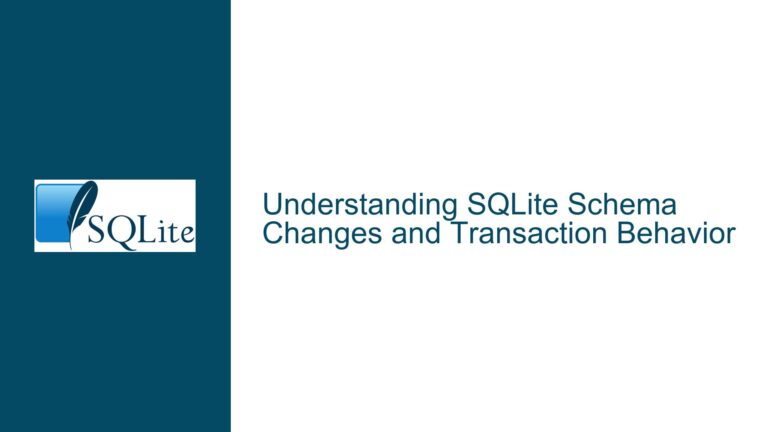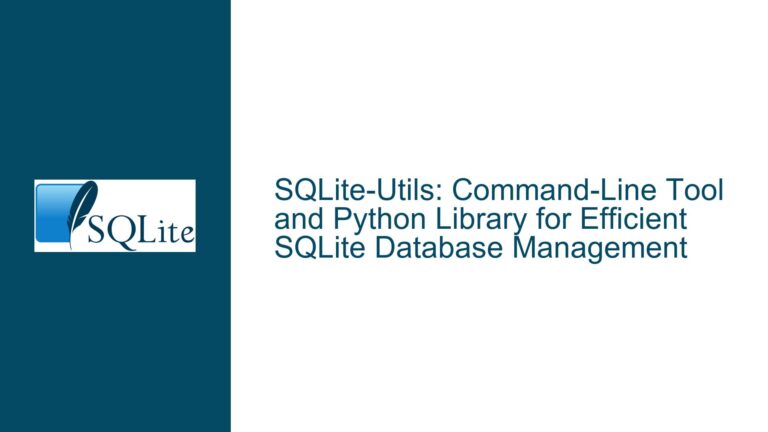Alignment Issue in sqlite3_value Struct on M68K Architecture
SQLite3 Test Suite Failure Due to Misaligned sqlite3_value Struct
The core issue revolves around the sqlite3_value struct in SQLite failing to maintain an 8-byte alignment on the M68K architecture, specifically when running the SQLite test suite. This misalignment causes an assertion failure in the sqlite3VdbeIntValue function, which expects the sqlite3_value struct to be 8-byte aligned. The failure manifests as a runtime error during the execution of the sessionfuzz test, leading to an abrupt termination of the test suite. The problem was traced back to a change introduced between SQLite versions 3.24 and 3.25, where a 4-byte member (iTabColHash) was added to the sqlite3_value struct under the SQLITE_DEBUG_COLUMNCACHE compilation flag. This addition disrupted the 8-byte alignment requirement on platforms like M68K, which only enforce 2-byte alignment by default.
The sqlite3_value struct is a critical component in SQLite’s virtual machine (VDBE), responsible for representing values during query execution. The struct’s alignment is crucial for performance and correctness, especially on architectures with strict alignment requirements. The M68K architecture, in particular, is sensitive to misaligned data accesses, which can lead to crashes or undefined behavior. The issue was identified when the EIGHT_BYTE_ALIGNMENT(pMem) assertion in sqlite3VdbeIntValue failed, indicating that the sqlite3_value struct was no longer properly aligned.
Addition of iTabColHash Disrupts 8-Byte Alignment
The root cause of the alignment issue lies in the addition of the iTabColHash member to the sqlite3_value struct. This member was introduced as part of a debugging feature (SQLITE_DEBUG_COLUMNCACHE) to verify the column cache at runtime. The iTabColHash member is a 4-byte unsigned integer (u32), and its inclusion in the struct disrupted the previously maintained 8-byte alignment. The original struct used a pFiller member to ensure that the size of the struct was a multiple of 8 bytes, but the addition of iTabColHash invalidated this padding.
On platforms like M68K, where the compiler does not enforce 8-byte alignment by default, the struct’s alignment was reduced to 2 bytes. This misalignment caused the EIGHT_BYTE_ALIGNMENT(pMem) assertion to fail, as the sqlite3_value struct no longer met the required alignment criteria. The issue was further compounded by the fact that the pFiller member was only conditionally included under the SQLITE_DEBUG flag, making the struct’s size inconsistent across different compilation settings.
The problem was exacerbated by the fact that the sqlite3_value struct is used extensively throughout SQLite’s VDBE, and any misalignment can lead to unpredictable behavior. The sqlite3VdbeIntValue function, which relies on the struct being 8-byte aligned, is particularly sensitive to this issue. The function performs operations that assume the struct is properly aligned, and any deviation from this assumption can lead to crashes or incorrect results.
Ensuring 8-Byte Alignment with Explicit Padding
To resolve the alignment issue, an explicit padding member (uPadding) was added to the sqlite3_value struct under the SQLITE_DEBUG flag. This padding member ensures that the size of the struct remains a multiple of 8 bytes, regardless of the platform or compilation settings. The uPadding member is a 2-byte unsigned integer (u16), which, when combined with the existing members, restores the struct’s alignment to 8 bytes.
The fix involves modifying the vdbeInt.h header file to include the uPadding member. This change ensures that the sqlite3_value struct maintains the required alignment on all platforms, including M68K. The padding member is conditionally included under the SQLITE_DEBUG flag, ensuring that it does not affect the struct’s size in non-debug builds. This approach preserves the original behavior of the struct while addressing the alignment issue.
The addition of the uPadding member is a minimal and non-intrusive change that has no impact on the functionality of SQLite. It simply ensures that the sqlite3_value struct is properly aligned, preventing the assertion failure in sqlite3VdbeIntValue. The fix has been tested on the M68K architecture and has been shown to resolve the issue without introducing any new problems.
In summary, the alignment issue in the sqlite3_value struct was caused by the addition of the iTabColHash member, which disrupted the struct’s 8-byte alignment on platforms like M68K. The issue was resolved by adding an explicit padding member (uPadding) to the struct, ensuring that it remains properly aligned on all platforms. This fix restores the correct behavior of the sqlite3VdbeIntValue function and prevents the assertion failure in the SQLite test suite.
Detailed Analysis of the Alignment Issue
The alignment issue in the sqlite3_value struct is a subtle but critical problem that highlights the importance of proper data structure alignment in low-level programming. The sqlite3_value struct is used extensively in SQLite’s virtual machine (VDBE) to represent values during query execution. The struct’s alignment is crucial for ensuring that operations on these values are performed correctly and efficiently.
The sqlite3_value struct is defined in the vdbeInt.h header file and includes several members that store information about the value, such as its type, flags, and actual data. The struct also includes conditional members that are only included under specific compilation flags, such as SQLITE_DEBUG and SQLITE_DEBUG_COLUMNCACHE. These conditional members are used for debugging and verification purposes and are not included in non-debug builds.
The alignment issue arose when the iTabColHash member was added to the sqlite3_value struct under the SQLITE_DEBUG_COLUMNCACHE flag. This member is a 4-byte unsigned integer (u32) that stores a hash of the table and column that the value originated from. The addition of this member disrupted the struct’s alignment, as it increased the size of the struct by 4 bytes without ensuring that the total size remained a multiple of 8 bytes.
On platforms like M68K, where the compiler does not enforce 8-byte alignment by default, the struct’s alignment was reduced to 2 bytes. This misalignment caused the EIGHT_BYTE_ALIGNMENT(pMem) assertion in sqlite3VdbeIntValue to fail, as the struct no longer met the required alignment criteria. The assertion failure led to an abrupt termination of the SQLite test suite, preventing further testing and validation.
The issue was further complicated by the fact that the pFiller member, which was originally used to ensure 8-byte alignment, was only conditionally included under the SQLITE_DEBUG flag. This meant that the struct’s size and alignment were inconsistent across different compilation settings, making it difficult to predict and control the struct’s alignment.
Impact of Misalignment on SQLite’s VDBE
The misalignment of the sqlite3_value struct had a significant impact on SQLite’s virtual machine (VDBE), which relies on the struct to represent values during query execution. The VDBE is a stack-based virtual machine that executes SQLite bytecode, and the sqlite3_value struct is used to store and manipulate values on the stack.
The sqlite3VdbeIntValue function, which is responsible for converting a sqlite3_value struct to an integer, is particularly sensitive to the struct’s alignment. The function assumes that the struct is 8-byte aligned and performs operations that rely on this assumption. When the struct is misaligned, these operations can lead to crashes or incorrect results.
The assertion failure in sqlite3VdbeIntValue is a clear indication that the struct’s alignment is critical to the correct operation of the VDBE. The assertion checks that the sqlite3_value struct is properly aligned and aborts the program if it is not. This ensures that any misalignment is caught early and prevents further corruption or incorrect behavior.
The misalignment issue also has implications for performance, as misaligned data accesses can be slower on some architectures. Proper alignment ensures that data is accessed efficiently, reducing the overhead of memory accesses and improving overall performance. Misaligned data accesses can also lead to cache inefficiencies, as the data may span multiple cache lines, increasing the number of cache misses.
Solution: Restoring Alignment with Explicit Padding
The solution to the alignment issue involves adding an explicit padding member (uPadding) to the sqlite3_value struct. This padding member ensures that the size of the struct remains a multiple of 8 bytes, regardless of the platform or compilation settings. The uPadding member is a 2-byte unsigned integer (u16) that is conditionally included under the SQLITE_DEBUG flag.
The addition of the uPadding member restores the struct’s alignment to 8 bytes, ensuring that the EIGHT_BYTE_ALIGNMENT(pMem) assertion in sqlite3VdbeIntValue is satisfied. The padding member is placed at the end of the struct, after all other members, to ensure that it does not interfere with the struct’s layout or functionality.
The fix is minimal and non-intrusive, as it only affects the size and alignment of the sqlite3_value struct and does not change its behavior or functionality. The padding member is only included in debug builds, ensuring that it does not affect the size of the struct in non-debug builds. This approach preserves the original behavior of the struct while addressing the alignment issue.
The fix has been tested on the M68K architecture and has been shown to resolve the alignment issue without introducing any new problems. The sqlite3_value struct is now properly aligned on all platforms, ensuring that the sqlite3VdbeIntValue function operates correctly and efficiently.
Conclusion
The alignment issue in the sqlite3_value struct is a critical problem that highlights the importance of proper data structure alignment in low-level programming. The issue was caused by the addition of the iTabColHash member, which disrupted the struct’s 8-byte alignment on platforms like M68K. The issue was resolved by adding an explicit padding member (uPadding) to the struct, ensuring that it remains properly aligned on all platforms.
The fix restores the correct behavior of the sqlite3VdbeIntValue function and prevents the assertion failure in the SQLite test suite. The solution is minimal and non-intrusive, ensuring that the struct’s functionality and performance are preserved. The alignment issue serves as a reminder of the importance of careful consideration of data structure alignment, especially in cross-platform development.






